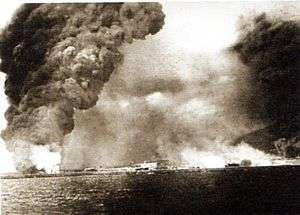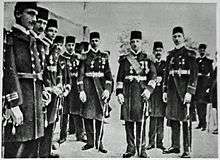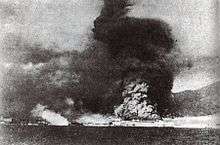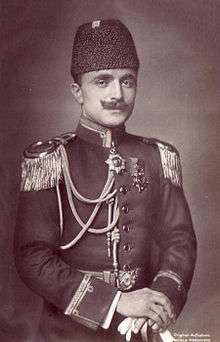Black Sea Raid
| Black Sea Raid | |||||||
|---|---|---|---|---|---|---|---|
| Part of World War I | |||||||
 Oil tanks in Novorossiysk harbour burn following bombardment | |||||||
| |||||||
| Belligerents | |||||||
|
|
| ||||||
| Commanders and leaders | |||||||
|
|
| ||||||
| Strength | |||||||
|
1 battlecruiser 1 light cruiser 1 protected cruiser 1 torpedo cruiser 4 destroyers 1 gunboat |
Shore defences 1 pre-dreadnought 1 minelayer 1 gunboat 3 destroyers | ||||||
| Casualties and losses | |||||||
| 1 battlecruiser damaged |
1 minelayer scuttled 1 gunboat sunk 1 destroyer damaged Numerous merchant vessels damaged or destroyed[Note 1] | ||||||
The Black Sea Raid was an Ottoman naval sortie against Russian ports in the Black Sea on 29 October 1914, supported by Germany, that brought the Ottoman Empire into World War I. The attack was conceived by Ottoman War Minister Enver Pasha, German Admiral Wilhelm Souchon, and the German foreign ministry.
Germany had been hoping that the Ottomans would enter the war to support them, but the Porte in Istanbul was undecided. The pro-German Enver Pasha began secretly conspiring with the German ambassador on bringing the Empire into the war. Attempts to secure widespread support in the government failed, so Enver decided conflict would have to be instigated. With the help of the Ottoman naval minister and German Admiral Wilhelm Souchon, Enver arranged for the Ottoman fleet to go out to sea on 29 October to supposedly perform maneuvers. They were to provoke Russian vessels and then accuse them of inciting war. Instead, Souchon raided the Russian coast in a flagrant display of hostility, causing little lasting damage but enraging the Russians.
Attempts by anti-war officials in Istanbul to apologize for the incident were botched by Pasha. The British quickly retaliated with naval attacks in the Dardanelles. The Russians declared war on 2 November, followed by the British and the French three days later. The Ottomans didn't officially declare war until 11 November.
Background
The Ottomans had been desperately trying to secure an alliance with a great power before the war 1914, but most of their attempts failed.[9] Even when the Germanophile Ottoman War Minister Enver Pasha directly proposed an alliance on 22 July to the German ambassador in Istanbul, Hans Freiherr von Wangenheim, he was turned down. Kaiser Wilhelm II overruled Wagenheim two days later, and an Ottoman draft for an alliance was delivered in Berlin on 28 July (the same day World War I began). The July Crisis had now come to a breaking point and it appeared Germany would be fighting a two-front war. Hesitant to make any more significant military obligations, Wangenheim was authorized by German Chancellor Theobald von Bethmann-Hollweg to sign the agreement only if the Ottoman Empire would "undertake action against Russia worthy of its name."[10] On 1 August, Enver Pasha offered Wangenheim the new battleship Sultân Osmân-ı Evvel in exchange for German protection. This was likely a clever ploy; the British had already seized the Sultan Osman-ı Evvel and the battleship Reşadiye, which were under construction in their shipyards. Wagenheim and the majority of the Ottoman Porte were unaware of this. Enver probably already knew of the seizure, since actually releasing the battleship to a foreign nation would've caused an uproar in the public and the government. Ambassador Wagenheim signed the treaty the next day, creating the secret Ottoman–German alliance.[11]
However, the alliance didn't automatically bring the Ottomans into World War I as Germany had hoped. The literal wording of the treaty obligated Germany to oppose any foreign infringements on Ottoman territory (particularly by Russia) but only required that the Ottoman Empire assist Germany as per the latter's own terms with Austria-Hungary. Since Germany had proactively declared war on Russia several days before Austria-Hungary, this didn't compel the Ottoman Empire to join the conflict.[12] Grand Vizier Said Halim and Finance Minister Djavid Bey were opposed to Ottoman involvement in the war and viewed the alliance as a passive agreement.[13]
Meanwhile, in the Mediterranean, the German battlecruiser SMS Goeben and the light cruiser SMS Breslau were cruising off of French Algeria. Admiral Wilhelm Souchon, the squadron's commander, had been holding his position in order to interfere with Entente troop convoys. He had received orders on 3 August that his ships should retreat to Ottoman waters, but chose to linger for one day and shell two ports. It had already been arranged on 1 August between the Germans and Enver that Souchon's squadron would be allowed safe passage.[14] While coaling in Messina, Souchon received a telegram rescinding these orders, as other Ottoman officials now learning of Enver's deal objected to the plan. With the Royal Navy in hot pursuit, Souchon continued east towards the Aegean Sea. On 8 August, he decided to force the issue and dispatched a support ship to Istanbul with a message for the German naval attaché to give to the Ottomans: he needed immediate passage through Dardanelles on the grounds of "military necessity" and was prepared to enter them "without formal approval." On the morning of 10 August, Souchon was given permission to enter the straits.[15]
The day before, the Porte had proposed to Wangenheim that a fictitious purchase of the German ships be arranged, so there presence would not compromise Ottoman neutrality. The next day the German chancellor had cabled Wagenheim, rejecting the idea and demanding that the Ottomans immediately join the war. The Grand Vizier accosted Wagenheim on the premature arrival of the ships and repeated the demand for a fictitious sale. The Ottoman government subsequently declared that it had purchased both ships for 80 million marks. On 14 August, Wagenheim advised the German government that it would be best to go along with the sale, lest they risk angering the Ottomans.[16]
On 16 August, the ships were formally integrated into the Ottoman Navy while their crews were given new uniforms and formally reenlisted.[16] The British had thought this action was meant to counterbalance their seizure of the Ottoman battleships, but this was not strictly the case. The Ottomans feared the Entente, particularly Russia, would attempt to partition the empire if they won the war, whereas Germany and Austria-Hungary would not. Once the British became aware of this, they feared that the Ottomans were more likely to enter the conflict in Germany's favour.[17]
Following Russia's failures in its operations against Germany in mid August, Russian incursion seemed unlikely. Enver Pasha now began to move his defensive policy towards an aggressive one.[18]
Prelude

In a discussion over the weekend of 12–13 September, Enver gave Souchon permission to take his ships into the Black Sea to perform maneuvers. The Ottoman naval minister, Djemal Pasha, discovered Souchon's plans and strictly forbade him from moving out of the Bosphorus.[19] The Ottoman cabinet debated the matter over the next few days, and on 17 September Enver told Souchon that his authorization to operate in the Black Sea was "withdrawn until further notice." Furious, Souchon went ashore the next day and berated Grand Vizier Halim for his government's "faithless and indecisive behavior" while threatening to take matters into his own hands and "behave as dictated by the conscience of a military officer."[20] He subsequently demanded that Enver, at the very least, allow the German light cruiser to stage exercises near the mouth of the Bosphorus with several Ottoman destroyers. Here Souchon hoped the ships could engage the Russian Black Sea Fleet and bring the Ottoman Empire into the war. Enver promised to do what he could.[20]
On 24 September, Souchon was made vice admiral and commander-in-chief of the Ottoman Navy.[4]
On 26 September Enver ordered the closing of the Dardanelles to foreign shipping without the consultation of his advisers. This had an immediate effect on the Russian economy, as nearly half of the country's exports traveled through the straits.[18]
On 9 October Enver told Ambassador Wangenheim that he had won the sympathy of Prime Minister Mehmed Talaat and Halil Bey, President of the Chamber of Deputies, and that he planned on securing the support of Djemal Pasha. If that failed, he would provoke a Cabinet crises and create a pro-war government.[21] After gaining Djemal's sympathies, the conspiring Ottomans informed the Germans that they would go to war as soon as they received the equivalent of two million lira in gold, money the Germans knew the Ottoman Empire would need to fund a war. The money was shipped through neutral Romania, and the last of it arrived on 21 October.[21]
Informants working for the Russian ambassador in Istanbul, Mikhail Nikolayevich von Giers, forwarded the information about the payments to Russian Foreign Minister Sergey Sazonov. Sazonov had suspected the Ottomans' and Germans' intentions, and warned the Russian naval commanders in Sebastopol to be prepared for an attack. On 21 October, Admiral Kazimir Ketlinski assured the foreign minister that the Black Sea Fleet was "completely ready" for action.[5]
On 22 October 1914, Pasha covertly presented a series of plans to Wangenheim on how to bring the country into the war. The Germans approved of an attack on Russian naval forces.[6] At the last minute Talaat and Halil changed their minds and resolved that the Ottomans should keep the gold and remain neutral. Talaat soon reverted to his old position. Enver gave up on trying to unify the government to pass a declaration of war, and concluded that the Russians would to need to be provoked into declaring war to instigate desirable action.[21] He told the Germans this on 23 October, and assured them that he would only need Minister Djemal's support. The next day Enver told Admiral Souchon he should take the fleet into the Black Sea and attack Russian ships if a "suitable opportunity presented itself." Djemal then secretly ordered all Ottoman naval officers to strictly follow Souchon's directives.[22]
On 25 October, Ambassador Girs forwarded one of his informant's predictions to Sazonov: the attack would take place on 29 October.[5]
Raid
On 27 October, the Ottoman fleet put to sea under the guise of performing maneuvers. Enver had originally envisioned an encounter at sea in which the Ottoman's would claim self-defence, but Admiral Souchon conceived a direct assault on Russian ports. He would later say his intention was "to force the Turks, even against their will, to spread the war."[23] The German battlecruiser, now known as Yavuz Sultan Selim, was to sail with two destroyers and a gunboat to attack Sebastopol. The light cruiser Breslau, now known as Midilli, protected cruiser Hamidieh, and the torpedo cruiser Berk-i Satvet were to attack Novorossiysk and Feodosia. Three destroyers were detailed for Odessa. On the way, one of these destroyers experienced engine trouble and was forced to turn back.[6]
Russian naval officers were under specific instruction not to fire first on the Ottomans in the event of a confrontation. The Russian government wanted to make it clear to any third party that the Ottomans would be the ones to instigate hostilities.[5]
Odessa
Shortly after 03:00 on 29 October, the destroyers Muavenet and Gairet entered the harbour of Odessa. From a distance of less than 70 yards, a torpedo was launched into the Russian gunboat Donetz, quickly sinking it. The two destroyers proceeded to damage merchant vessels, shore installations, five oil tanks, and a sugar refinery.[6]
The destroyers had actually conducted their raid earlier than Souchon had intended, and the Russians managed to radio a warning to the forces in Sebastopol. By the time the Yavuz arrived, the coastal artillery was manned.[6]
Sebastopol
Just before 06:30, Yavuz sighted Sebastopol and proceeded to bombarded the port for 15 minutes. During this time she exchanged fire with the pre-dreadnought Georgii Pobedonosets and shore batteries.[2] Three heavy caliber shells from the batteries managed to damage the Yavuz before she withdrew.[3] The loaded Russian minelayer Prut happened upon the attack and was scuttled by her crew to avoid being detonated. Since Prut's arrival had been expected, the defensive minefield around the port was inoperative. By the time it was activated 20 minutes later, the Ottomans had cleared the area.[24] Three Russian destroyers attempted to pursue, but their attack dissolved after the lead ship was struck by a shell.[6]
Feodosia

At around the same time Hamidieh arrived off of Feodosia. Seeing no signs of armed opposition, a German and a Turkish officer went ashore to warn the civilian population before bombarding the port two hours later.[6][25]
Yalta
After attacking Feodosia, Hamidieh bombarded Yalta, setting several granaries on fire.[7]
Novorossiysk
Shortly before 10:50, Berk-i Satvet sent a shore party to warn the defenceless population of Novorossiysk, before opening up with her guns. She was soon thereafter joined by the Midilli, which had been busy laying mines in the Kerch Strait.[6] Midilli fired a total of 308 shells, sinking several Russian grain cargo ships and destroying about 50 oil tanks.[5] On her way back to Ottoman territory, Midilli attempted to cut Sebastopol's undersea cable with Varna, Bulgaria, but failed.[26]
Aftermath
On the afternoon following the raid, Souchon radioed Istanbul that Russian ships had "shadowed all movements of the Turkish fleet and systematically disrupted all exercises," and as such had "opened hostilities." The Russians attempted to but were unable to pursue the Ottoman fleet. The raiding force returned to Ottoman waters on 1 November.[2]
The Ottoman press reported on the action on 31 October, claiming that the Russians had planned on mining the Bosphorus and destroying their fleet without a formal declaration of war. As such, the Ottomans had retaliated after an engagement at sea by bombarding the Russian coast.[8]
German military officers were disappointed by the limited extent of the attack, which ultimately achieved more political goals than strategic ones.[1] Russia's Black Sea Fleet was not seriously damaged by the raid. The gunboat Donetz was later raised and returned to service.[24]
Ramifications

A two-day political crisis followed the raid. It was obvious to the Ottoman government what Enver Pasha had allowed to occur. As soon as the news of the attack reached Istanbul, the Grand Vizier and the Cabinet forced Enver to wire a ceasefire order to Souchon. Several officials, including the Grand Vizier, threatened to resign in protest. Four later would, including Djavid Bey.[27] Though many in the government thought it opportune to attack Russia, party unity was regarded as vital and a letter of apology was soon drafted. On 31 October Enver informed the Germans of the planned apology and said there was nothing he could do.[23]
The British, ill-informed of the situation in Istanbul, believed the entire Ottoman Porte was conspiring with the Germans. The British Cabinet sent an ultimatum to the Ottomans, demanding that they remove Admiral Souchon and his German subordinates from their posts and expel Germany's military mission,[23] which consisted of approximately 2,000 men.[28] The Ottomans did not comply. On 31 October, First Sea Lord Winston Churchill, acting on his own initiative, ordered British forces in the Mediterranean to commence hostilities against the Ottoman Empire. This wasn't carried out immediately, so the Ottomans were unaware of what had transpired.[23] The Russian Foreign Ministry withdrew Ambassador Girs from Istanbul.[6]
Meanwhile, Enver Pasha, still fearing that the Russians would accept the Ottoman apology, decided to interfere. Just before the message was sent, Enver inserted a passage that accused the Russians of instigating the conflict. On 1 November the message arrived in Petrograd. Foreign Minister Sergey Sazonov responded with an ultimatum, demanding that the Ottomans expel the German military mission. The Ottomans rejected this proposal.[28]
That same day British forces in the Mediterranean carried out Churchill's orders by attacking Ottoman shipping off of the port of İzmir. That night at an Ottoman Cabinet meeting, the Grand Vizier's anti-war faction was forced to accept that the Empire was at war, and that there was little they could do to avoid conflict.[29] The Russians declared war on the Ottoman Empire on 2 November 1914. Admiral Andrei Eberhardt immediately ordered Russia's fleet to retaliate. On 4 November, a Russian task force bombarded Zonguldak.[30]
On 3 November British warships bombarded outer forts in the Dardanelles.[6] Two days later Britain extended their declaration of war to the Ottoman Empire, as did France.[26]
Due to these attacks, there was a common impression in Britain that Churchill had brought the Ottomans into the war. Prime Minister Lloyd George held this belief for several years to come. In the meantime, Churchill tried to promote the advantages of the conflict, such as the possibility of territorial gains in the Middle East. This reason would ultimately bring Italy and Balkans nations like Greece into the war.[31]
The Porte finally declared war on the Triple Entente on 11 November. Three days later Ottoman Sultan Mehmed V called for a Jihad campaign by Sunni and Shia Muslims against the Western powers.[32]
Notes
- ↑ The number of merchantmen damaged and destroyed is disputed. Erickson and Sondhaus claim that only 6 vessels were lost.[1][2] Dowling and Tucker state that the total casualties from the entire raid amount to 6 vessels sunk and around 12 damaged.[3][4] McMeekin and Miller state that 14 vessels alone were sunk at Novorossiysk[5][6] but McMeekin later lowered that estimate to 12 vessels sunk.[7]</ref>
Unknown human losses[Note 2] The Ottoman press claimed that 75 sailors were captured.[8] - ↑ Most sources do not list any statistics on Russia's human losses. Kieser states that the Ottomans "took dozens of crew prisoners-of-war."<ref>Kieser 2015
References
Citations
- 1 2 Erickson 2001, p. 36
- 1 2 3 Sondhaus 2014, p. 107
- 1 2 Tucker 2014, p. 263
- 1 2 Dowling 2014, p. 131
- 1 2 3 4 5 McMeekin 2011, p. 111
- 1 2 3 4 5 6 7 8 9 10 Miller 1999
- 1 2 McMeekin 2015, p. 128
- 1 2 New York Times Company 1917, pp. 1032–1033
- ↑ McMeekin 2012, p. 106
- ↑ McMeekin 2012, p. 107
- ↑ Fromkin 2010, pp. 60–61
- ↑ McMeekin 2012, p. 108
- ↑ Gingeras 2016, p. 107
- ↑ Fromkin 2010, p. 62
- ↑ McMeekin 2012, p. 111
- 1 2 Fromkin 2010, p. 65
- ↑ Fromkin 2010, p. 67
- 1 2 Fromkin 2010, p. 70
- ↑ McMeekin 2015, p. 120
- 1 2 McMeekin 2015, p. 121
- 1 2 3 Fromkin 2010, p. 71
- ↑ Halmilton, Herwig 2003, p. 353
- 1 2 3 4 Fromkin 2010, p. 72
- 1 2 Halpern 2012
- ↑ Erickson 2001, p. 35
- 1 2 Sondhaus 2014, p. 108
- ↑ Kent 2005
- 1 2 McMeekin 2011, p. 112
- ↑ Fromkin 2010, p. 73
- ↑ Sondhaus 2014, p. 109
- ↑ Fromkin 2010, p. 74
- ↑ Reynolds 2011, p. 122
Works consulted
- Dowling, Timothy C., ed. (2014). Russia at War: From the Mongol Conquest to Afghanistan, Chechnya, and Beyond. ABC-CLIO. ISBN 978-1-59884-948-6.
- Erickson, Edward J. (2001). Ordered to Die: A History of the Ottoman Army in the First World War. Contributions to the Study of American Literature. 201 (illustrated ed.). Greenwood Publishing Group. pp. 35–36. ISBN 978-0-313-31516-9.
- Fromkin, David (2010). Peace to End All Peace: The Fall of the Ottoman Empire and the Creation of the Modern Middle East. Macmillan. ISBN 978-1-4299-8852-0.
- Gingeras, Ryan (24 March 2016). Fall of the Sultanate: The Great War and the End of the Ottoman Empire 1908–1922. The Greater War (illustrated ed.). Oxford University Press. ISBN 978-0-19-967607-1.
- Halpern, Paul G. (11 October 2012). A Naval History of World War I. Naval Institute Press. ISBN 978-1-61251-172-6.
- Hamilton, Richard F.; Herwig, Holger H., eds. (24 February 2003). The Origins of World War I. Cambridge University Press. ISBN 978-1-107-39386-8.
- Kent, Marian (2005). The Great Powers and the End of the Ottoman Empire. Routledge. ISBN 978-1-135-77799-9.
- Kieser, Hans-Lukas (28 September 2015). World War I and the End of the Ottomans: From the Balkan Wars to the Armenian Genocide. I.B.Tauris. ISBN 978-0-85772-947-7.
- McMeekin, Sean (7 May 2012). The Berlin-Baghdad Express (illustrated, reprint ed.). Harvard University Press. ISBN 978-0-674-05853-8.
- McMeekin, Sean (2015). The Ottoman Endgame: War, Revolution, and the Making of the Modern Middle East, 1908–1923 (illustrated ed.). Penguin Publishing Group. ISBN 978-1-59420-532-3.
- McMeekin, Sean (2011). The Russian Origins of the First World War. Harvard University Press. ISBN 978-0-674-06320-4.
- Miller, Geoffrey (1999). "Turkey Enters the War and British Actions". www.gwpda.org. Great War Primary Document Archive. Retrieved 1 August 2016.
- The New York Times Current History of the European War. New York Times Company. 1917.
- Reynolds, Michael A. (2011). Shattering Empires: The Clash and Collapse of the Ottoman and Russian. Cambridge University Press. ISBN 978-1-139-49412-0.
- Sondhaus, Lawrence (27 August 2014). The Great War at Sea: A Naval History of the First World War (illustrated ed.). Cambridge University Press. ISBN 978-1-107-03690-1.
- Tucker, Spencer C., ed. (2014). World War I: The Definitive Encyclopedia and Document Collection: The Definitive Encyclopedia and Document Collection. I (illustrated, revised ed.). ABC-CLIO. ISBN 978-1-85109-965-8.